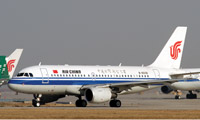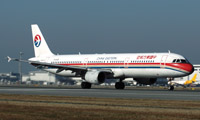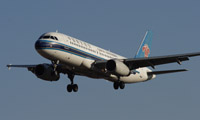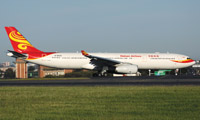China
Fuel price takes its toll on China's carriers
DANIEL TSANG analyses the 2011 performances of the Mainland’s leading airlines and looks at their strategies for the year ahead
June 1st 2012
After a turnaround in 2010 when Chinese carriers posted a collective profit of 35.1 billion yuan (US$5.6 billion) on the back of a booming domestic market, soaring fuel prices dented profits in 2011 with a decline of 17.7% to 27.8 billion yuan. This was despite a 17.9% growth in revenue to 353 billion yuan. Read More »
Nevertheless the Chinese carriers continued to show robust passenger traffic growth, with a 9.5% rise in passengers carried to 293 million, according to the annual report released by the Civil Aviation Administration of China (CAAC) in May.
In particular, the domestic market increased 9.5% to 272 million travellers, and passengers carried on international flights and regional flights to Hong Kong and Macau rose a healthy 9.7% and 13.1% respectively.
This strong growth continued into 2012, with the Chinese carriers reporting a 10.9% rise in revenue to 73 billion yuan from a year ago, for the first three months of the year.
However, this stellar expansion was dwarfed by an 18.7% increase in 2012 first quarter expenses to 71.2 billion yuan. The increased costs were primarily driven by a 11% increase in jet fuel prices to around US$140 a barrel, according to the International Air Transport Association (IATA), which resulted in a hefty 75.9% decline in the Chinese airlines’ first-quarter profit of one billion yuan (*).
Despite a 1.6% cut in domestic fuel charges in May, the continuing global economic volatility, coupled with a demand decline for Chinese exports and sustained high oil prices will weigh on the balance sheets of Mainland carriers for the rest of 2012.
Air China (AC)
 |
| Air China: attained the highest passenger yield in 2011 among the ‘Big Three’ China carriers |
The Chinese national flag carrier was again China’s most profitable airline in 2011, but its reported net profit of 7.06 billion yuan was 42.7% down on 2010. Its income included 959 million yuan from its 29.99% shareholding in Cathay Pacific Airways.
The profit fall was the result of a 28.8% increase in expenses to 92.2 billion yuan, which outstripped a 19.3% rise in AC’s revenue to 98.4 billion yuan. Fuel costs shot up 44% to 34.7 billion yuan.
Traffic measured in revenue passenger kilometres (RPKs) rose 16.9% to 123.5 billion whereas capacity, measured in available seat kilometres (ASKs) increased 14.8%, which resulted in a 1.44 percentage point rise in passenger load factor to 81.5%.
AC was the largest Chinese carrier by revenue and attained the highest passenger yield among the “Big Three” carriers, at 0.7 yuan per RPK, largely owing to its main hub position in the capital Beijing. It was also the carrier most exposed to the international market where long-haul competition with foreign carriers was fierce.
The international market accounted for 29.9% of AC’s capacity and 65.5% of its domestic network.
Figures available last month reveal that AC’s first quarter net profit attributable to shareholders slumped 85.7% to 239 million yuan compared with the same period in 2011.
An AC statement listed airspace, infrastructure and manpower limitations and slot constraints among the new challenges facing the carrier.
The challenging global economy also poses a challenge to Shanghai-based Air China Cargo (ACC), its cargo joint venture (JV) with Cathay Pacific, in which AC owns 51% of the shares.
Air cargo revenue declined 2.37% to 9.8 billion yuan last year with yield falling more than 3%. As competition in Shanghai’s market intensifies, with HNA Group’s Yangtze River Express and China Eastern Airlines’ China Cargo Airlines looking to capture a larger share of the shrinking Yangtze River Delta, ACC is expected to continue to struggle throughout the remainder of 2012.
As pressure continues to restrain market share, AC is aiming to strengthen its hub in the domestic market. The carrier has a 50% market share in Beijing and a 43% share in Shenzhen, following its 2010 acquisition of Shenzhen Airlines. It is now looking at Chengdu and Dalian where it launched in December, as revenue earners.
AC also launched Beijing Airlines in May with the goal to capture business jet travel demand from the capital. It will initially operate with an A318, a Dassault Falcon 7X, a Gulfstream G280, three G450s and a Bombardier Challenger 605 private jet. It will face stiff competition from HNA Group subsidiary, Capital Airlines, which has a commanding 90% market share and operates 24 business jets.
China Eastern Airlines (CEA)
 |
| China Eastern Airlines: the first Mainland carrier to sell high speed rail tickets |
Shanghai-based CEA, the least profitable of China’s “Big Three” carriers, has made progress in consolidating its operations and developing its Shanghai Pudong International Airport hub.
In 2011, net profit fell 13.4% to 4.58 billion yuan, primarily owing to a 35.3% increase in fuel costs to 29.2 billion yuan. Revenue rose 11.7% to 82.4 billion yuan. Operating expenses increased 15.3%, which led to a 26.8% fall in operating profit to 4.2 billion yuan.
RPKs increased 8.3%, to 13.4 billion, outstripping a 7.1% rise in capacity. As a result, CEA’s passenger load factor rose 0.91 percentage point to 78.9%.
Last year, the carrier joined the SkyTeam alliance and launched new services from Shanghai to Rome, Hamburg, Honolulu and Dubai, Kunming to Male and nine new domestic routes.
With the world economy in recession, CEA has a clear strategy of focusing on the domestic market. It has replaced its 24 B787 orders with 45 737NG aircraft. CEA has 68.8% of its passenger fleet in its domestic market with 27% operating on international routes.
The carrier is developing Kunming and Xi’an as its regional hubs through its Yunnan Airlines and China Northwest Airlines subsidiaries.
Notwithstanding the strong domestic growth, CEA has to face competition from high-speed rail (HSR), particularly the Beijing-Shanghai, Shanghai-Chengdu and Beijing-Shenzhen HSR services.
CEA recently denied the suspension of its Wuhan-Nanchang route was due to the HSR. However, according to local media reports, from April 2009 to March 2010, the total number of seats offered on the route had fallen 17.7% with the number of passengers carried declining from 1.23 million to 902,000 for the period.
It is thought CEA’s decision to sell high-speed rail train tickets, the first Chinese carrier to do so, coupled with its proposed low-cost JV with Australia’s Qantas Airways (Jetstar Hong Kong), will lessen the impact of HSR.
“Though the LCC may find it difficult to obtain slots into major China airports, we think the company may try to fly into nearby secondary cities and link the last leg with high-speed rail. This would partially relieve the impact of limited civil airspace capacity in China, create a channel for LCCs to tap into major cities in China and coincide with CEA’s announcement of its intention to sell high-speed rail tickets,” HSBC analysts said in a May research report.
The Hong Kong-based, US$198 million Jetstar Hong Kong plans to start operations in mid-2013, with three A320s, increasing to 18 aircraft by 2015.
CEA chairman, Liu Shaoyong, has projected a possible capacity share at Hong Kong International Airport of 6%-7% by 2015 for the new LCC. Such a goal may be ambitious, predict some analysts. According to a Wall Street Journal report, LCCs account for a 5% share at the airport, with Jetstar Asia accounting for only 0.5% of ASKs.
HNA Group subsidiaries, Hong Kong Airlines and Hong Kong Express, account for a 5% share, while Cathay Pacific, along with its wholly-owned subsidiary, Dragonair, holds a commanding 50% capacity share.
In the first-quarter of 2012, CEA reported a 73.7% decline in its net profit to 266.6 million yuan compared with 2011. Revenue rose 6% to 19.3 billion yuan.
Should the airline leverage its position at Shanghai Pudong with the merger of its cargo subsidiaries Great Wall Airlines, Shanghai Cargo Airlines and China Airlines Cargo, coupled with the fact that the Shanghai passenger market has more high-yield business traffic, CEA could improve its profitability.
A restructuring effort seeking a strategic investor, revealed by chairman Liu in March, may be the first step towards accomplishing that goal.
China Southern Airlines
 |
| China Southern Airlines: a six-fold weekly increase in flights between Guangzhou and Australia and New Zealand in 2011 |
China Southern Airlines (CSA), which took delivery of its first A380 last October, is looking to develop a four-hub strategy for its international operations at Guangzhou, Beijing, Urumqi and Chongqing in Sichuan.
The airline has pinned its hopes on the introduction of the A380 making CSA “China’s best, one of Asia’s best and a world-renowned” carrier.
CSA reported a 5% fall in 2011 net profit to 6.09 billion yuan over 2010, mainly due to a 39% increase in the price of jet fuel to 32.7 billion yuan. Revenue climbed 18.2% to 90.4 billion yuan and operating expenses soared by 23.8% to 87.1 billion yuan.
Passenger traffic rose 9.9% to 122.3 billion for the 12 months, outpacing 7.5% growth in capacity, which produced a 2.3% improvement in load factor to 81%.
The Guangzhou-based carrier designated only 18.4% of ASKs to the international market, the smallest among the “Big Three”, compared with 79.7% in its domestic market.
Despite this, in 2011 CSA achieved the largest increase in passenger yield among the “Big Three”, rising 8.1% to 0.67 yuan per RPK, albeit this was the lowest among the three major carriers.
CSA has a clear strategy of maintaining Guangzhou as its largest hub, the gateway of passengers from Australia to China and Europe. In 2011, the airline launched a number of international routes, including Auckland, Amsterdam, Tbilisi, Vancouver, Perth and Istanbul and increased flight frequencies to Sydney, Melbourne, Los Angeles, Paris, Brisbane and Auckland.
As a result, the carrier has achieved profitable international growth, tapping into the mining boom in Australia, enabling it to achieve the biggest increase in passenger yield among its Mainland rivals. This saw the number of flights between Guangzhou and Australia and New Zealand increase six-fold from seven flights a week to 42.
CSA achieved a 34.1% increase in international capacity last year alone.
Its Canton Route strategy, the Chinese version of the Kangaroo Route where traffic from Australia and New Zealand transits Singapore or Hong Kong - or now at Emirates or Etihad Airways’ hubs in Dubai and Abu Dhabi respectively – and on to London, aims to transform Guangzhou into “the best transit hub between Europe, China and Australia/New Zealand”, according to the carrier.
The airline made a 319 million yuan first-quarter profit in 2012, a 74.2% decline over the previous year, driven by a 23.8% increase in operating expenses to 23.4 billion yuan.
Domestically, the airline initially faced significant competition with the high-speed rail (HSR). Passenger traffic on the Guangzhou-Wuhan route plummeted 21.1% following the launch of the 93 billion yuan “Wuguang” high-speed line in late 2009. The number of daily flights on the Guangzhou-Wuhan route, particularly during the 2010 summer period, plunged 50% from 2009.
The situation has since stabilised with eight daily flights, down from around 12-14 a day before the HSR entered service.
For the remainder of 2012 and beyond, CSA aims to bolster its “Canton Route” strategy and to treble passenger numbers at its Urumqi hub from 4.3 million in 2009 to 12 million by 2015. Its strategy also aims to achieve annual growth of 15% at the northeastern Chinese port city of Dalian.
It remains to be seen whether CSA’s “Canton Route” strategy will prevail in the light of fierce competition from Middle Eastern and Asian carriers whose quality of inflight service is often regarded as best in class.
In addition, Guangzhou is traditionally the hub with the weakest passenger yields, as Beijing and Shanghai are the political and financial centres of China, respectively. A solution to this structural issue has yet to be developed.
Hainan Airlines
 |
| Hainan Airlines: ambitious international and domestic expansion plans |
Hainan Airlines has continued its ambitious expansion both internationally and domestically.
In 2011, the carrier reported a full-year profit attributable to shareholders of 2.63 billion yuan, a 12.7% decline over 2010 profit. A 21.1% rise in revenue to 26.3 billion yuan outpaced a 25.9% increase in expenses to 19.5 billion yuan.
Passenger traffic during the period increased 11.1% to 3.57 billion RPKs. Capacity rose 7.9% to 4.24 billion ASKs, which resulted in a 3% increase in load factor to 84.2%.
Hainan’s wholly-owned subsidiaries, Changan Airlines and Shanxi Airlines, reported net profits of 254 million yuan and 80 million yuan, respectively.
During 2011, the carrier launched 29 new routes, including eight international services to Okinawa, Male, Bangkok/Colombo, Busan, and Zurich from Beijing and Haikou-Singapore and Shanghai-Urumqi-Istanbul.
It also commenced flights to multiple Chinese cities, with some such as Shanghai-Shenzhen-Mumbai, Shenzhen-Hyderabad and Shenzhen-Kolkata, connecting to Indian cities.
This year, Hainan announced plans for 13 new routes, including four international routes, Hangzhou-Haikou-Singapore, Taiyuan-Haikou-Singapore, Beijing-Bangkok and Sanya-Taipei.
The airline will boost frequencies between Beijing and Berlin and Brussels and has started international code-share flights with American Airlines (AA) and Taiwan’s Uni Air, an EVA Air subsidiary.
To cope with its rapid expansion, Hainan has expressed interest in acquiring the Boeing 747-8 Intercontinental. Another HNA Group subsidiary, Hong Kong Airlines, has already ordered 10 of the planes, according to Orient Aviation sources.
Hainan expects to receive its first B787 in September and have a fleet of 10 B787s within three years.
The carrier’s first quarter profit fell 35.7% to 175.6 million yuan. Revenue for the three-month period rose 22.7%, to 7.06 billion yuan, from a year earlier, despite a 27.8% increase in expenses to 5.5 billion yuan.
Hainan’s parent company, Grand China Air, acquired total control of China Xinhua Airlines and Changan Airlines in 2011 and also increased its shareholding in Lucky Air to 40%.
The South China airline invested further in HNA Group subsidiary, Hong Kong Airlines, in 2011, increasing its share to 19.02%.
Hong Kong Airlines launched all-business flights from Hong Kong to London Gatwick in March. The South China Morning Post reported that flights, each costing US$389,000 to operate, were only 30% full in the first month.
Nevertheless, the airline plans a rapid expansion of its international operations, with 50 new aircraft joining its fleet by 2015. At present, an impasse between the Chinese government and European Union (EU) on the inclusion of its airlines in the EU’s emissions trading scheme (ETS) has led Hong Kong Airlines’ order for 10 A380s to be put on hold.
China’s ETS protest has also held up the completion of orders for more than 30 A330s from Chinese carriers.
The China Air Transport Association (CATA) said the ETS will cost Chinese carriers 800 million yuan annually.
Although the long-term outlook for the Chinese airline industry is bright, it is, like the global industry at large, facing challenging times.
Chinese Airlines
|
Chinese carriers’ 2011 annual results
|
|||||||||||||||||||||||||||||||||||||||||||||||||||||||||||||||
Chinese carriers’ traffic results 2011
|
||||||||||||||||||||||||||||||||||||||||||||||||||||||